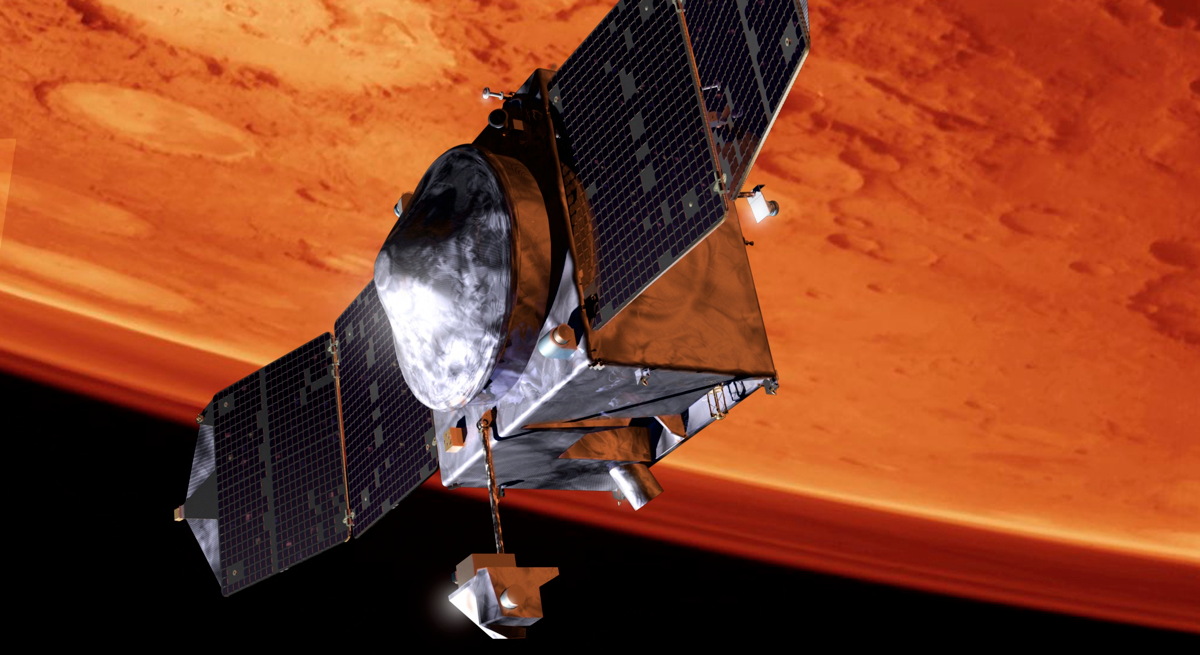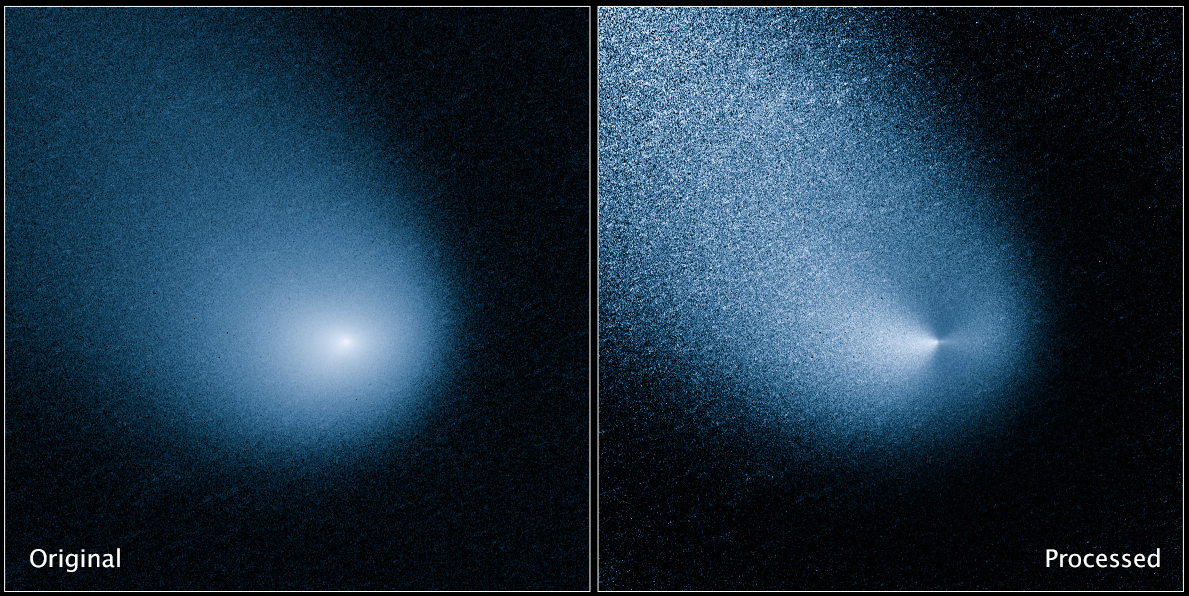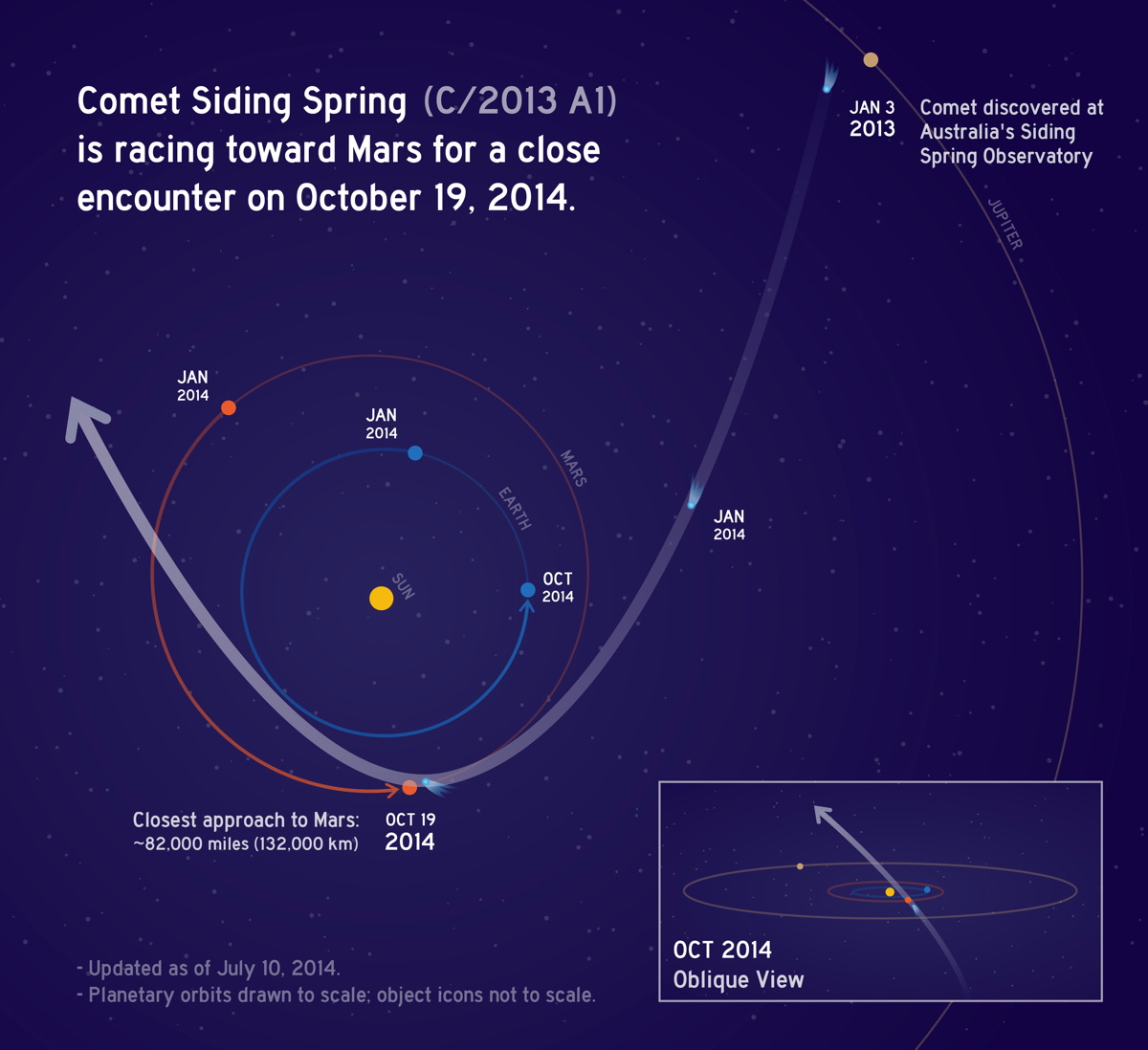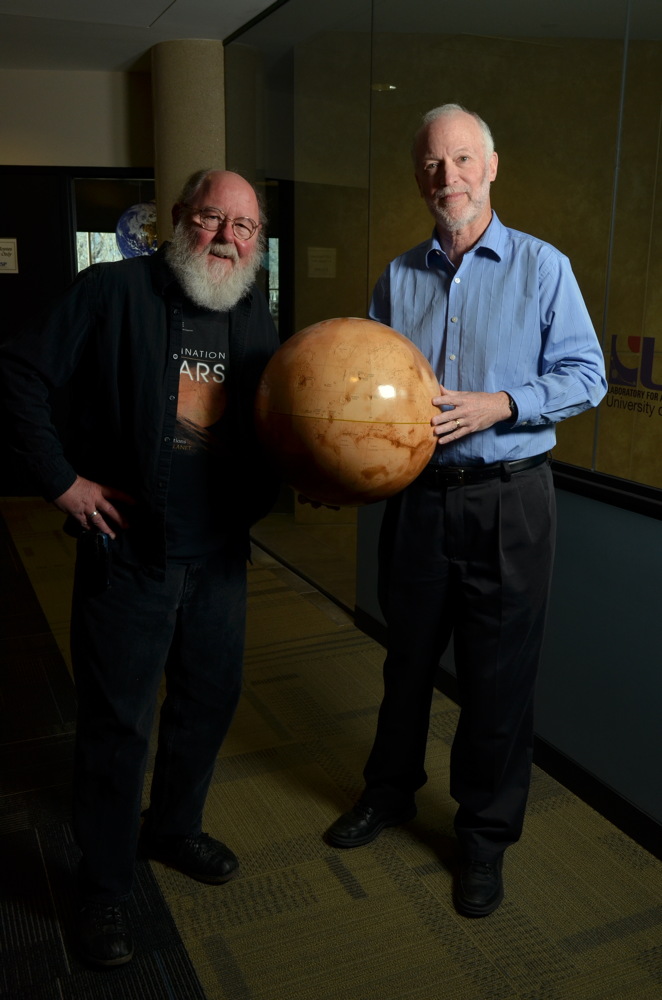
NASA Prepping Mars Probes, Rovers for Close Comet Flyby

NASA's Mars Atmosphere and Volatile EvolutioN mission (MAVEN) is closing in on the Red Planet. At the same time, an interloper, comet Siding Spring, is also approaching. Although the comet's nucleus will miss Mar's, Siding Spring's coma of dust particles might be wide enough to reach the planet.
Teams of scientists and spacecraft engineers have been studying the prospect that the comet's near miss with Mars might spew particles that could harm an international flotilla of spacecraft orbiting the planet.
The comet nucleus will make its closest approach to Mars on Oct. 19, and the planet's pass through the coma will take several hours. [See photos of MAVEN's launch to Mars]
As a new arrival at Mars, MAVEN will slip into orbit on Sept. 21, U.S. time. A few days later, India's Mars Orbiter Mission will also power itself into Mars orbit.
The two spacecraft add to an already existing fleet of Mars orbiters: Europe's Mars Express, and NASA's Mars Reconnaissance Orbiter and Mars Odyssey.
Outside the edge

"The dust risk appears to be significantly less than had originally been thought when the comet was first discovered," said Bruce Jakosky, principal investigator for MAVEN at the Laboratory for Atmospheric and Space Physics (LASP) at the University of Colorado Boulder.
Based on observations of the comet's coma and on models of dust-lifting and subsequent movement, it is likely that the dust cloud from the comet won't even reach Mars, Jakosky told Space.com.
Get the Space.com Newsletter
Breaking space news, the latest updates on rocket launches, skywatching events and more!
"Mars is right outside the edge of where the cloud is predicted to be at the time of passage by Mars," he said. "If it does expand a little more and encompass Mars, the predicted abundance of dust grains is thought to be significantly less than what had been expected, and is not likely to be a significant risk to the spacecraft."
Unseen jets?
That said, Jakosky noted that some damaging features of the comet might not show up in images or might not have been observed. Furthermore, scientific models that project comet activity are informed estimates created by analyzing average properties and processes.
"There could easily be unseen jets of dust that we aren't aware of that could get to Mars. As a result, we are still taking mitigations to minimize the potential damage of any dust," Jakosky said. MAVEN science instruments will probe the upper atmosphere of Mars before and after the encounter, he said, in order to see what effects the comet has on the Martian atmosphere.
"If there are effects from the dust or gas, we expect them to be primarily focused on the upper atmosphere, and we are, of course, uniquely suited to making those observations," Jakosky said.
Time of greatest risk
"Dust particles ejected from comet Siding Spring appear to be less of a hazard to our Mars spacecraft than once feared," said Richard Zurek, chief scientist of the Mars Program Office at the Jet Propulsion Laboratory (JPL) in Pasadena, California.

Mars itself may or may not encounter some speedy, millimeter-sized dust particles, Zurek told Space.com.
"Interestingly, the greatest danger appears to come 80-110 minutes after the closest approach of the comet nucleus," Zurek said. "That's when Mars comes closest to the trail of debris left by the comet. This short duration means that Mars orbiters could hide behind Mars at the time of greatest risk. And the Mars atmosphere is thick enough that it should protect Curiosity and Opportunity operating on the Mars surface."
Zurek said that NASA next needs to define the science observations that can safely take advantage of this unique opportunity to view a long-period comet up close.
JPL has provided comet modeler reports and a model environment overview to those space agencies that have requested them, Zurek said.
Rover comet watching
When comet Siding Spring passes closest to Mars on Oct. 19 at 18:29 UTC, it will be about 15:36 Mars local time on sol 783 for the Curiosity rover (a sol is a Martian day).
"So we'll be on the day side at that time," said Ashwin Vasavada, JPL's deputy project scientist for the Mars Science Laboratory.
"Curiosity's preliminary plan is to image the comet pre-dawn and post-dusk on that sol. Over the course of the mission, we have woken the rover at off hours several times to image the moons of Mars or other astronomical targets, so the imaging itself is straightforward," Vasavada said. [Amazing photos from the Curiosity rover]
The Mars rover's camera will probably not be able to see the comet's nucleus in great detail. It's possible that it will pick up any active jets or the coma, Vasavada said.
Skyworks

Planning is also underway to image the comet via the Opportunity Mars rover.
"About 100 minutes after the closest approach, Mars will reach its closest point to the trajectory of the comet and therefore pass close to the comet's debris trail," Vasavada said. "The best estimate is that Mars will pass just outside of the debris tail."
However, less likely scenarios predict that a large flux of good-sized particles will enter Mars' atmosphere. That would cause a meteor shower and alter the temperature and chemistry of the upper atmosphere, Vasavada said. "Curiosity's imaging post-dusk may capture the tail end of the meteor shower, depending on the cometary activity."
Shielding MAVEN
Jakosky said that MAVEN will observe the comet for about two days before and two days after the its closest approach.
In addition, Jakosky said that MAVEN's location in orbit will be phased so it is shielded from the dust by the planet for about 20 minutes during the period of peak dust risk. MAVEN's orientation we also be adjusted to present the minimum area cross section to the incoming dust. This will put the solar panels edge-on to the incoming dust.
Furthermore, MAVEN controllers will turn off the science instruments that could be damaged if dust hit them while they were turned on. The dust would not damage several instruments, even if they were turned on, so those will remain active during the encounter and will make observations.
Nevertheless, Jakosky said that, throughout this entire time period, spacecraft and instrument health and safety absolutely come first.
"If anything comes up that might jeopardize those, we will take appropriate actions," Jakosky said. "This could involve actions up to and including shortening or canceling the comet/Mars observations if they cannot be done safely."
Unprecedented opportunity
Lockheed Martin Space Systems Company's facility near Denver built MAVEN and is the spacecraft's flight-control hub. They, too, have been busy at work crafting plans to assure nothing untoward happens to the spacecraft, which is set to become the first spacecraft mission dedicated to surveying the upper atmosphere of Mars. [See Photos of Comet Siding Spring]
The team expressed some optimism.
"The size of the particles and the velocities those particles are reaching, they look like they are much less dangerous to everything," said Wayne Sidney, MAVEN's Mars Orbit Insertion team leader.
Sidney said that MAVEN operators will orient the vehicle in a preferential attitude to minimize its exposure to any particles. "We're doing everything possible to protect ourselves."
The posture being taken has turned "to one that is less worried about spacecraft safety and survival … to a little bit more of 'wow' … this is an unprecedented opportunity to actually study a comet that close to another planet," Sidney said.
"It's less life and death to, 'Cool, let's go take some data,'" he said.

Leonard David has been reporting on the space industry for more than five decades. He is former director of research for the National Commission on Space and is co-author of Buzz Aldrin's 2013 book "Mission to Mars – My Vision for Space Exploration" published by National Geographic. Follow us @Spacedotcom, Facebook and Google+. Original article on Space.com.
Join our Space Forums to keep talking space on the latest missions, night sky and more! And if you have a news tip, correction or comment, let us know at: community@space.com.

Leonard David is an award-winning space journalist who has been reporting on space activities for more than 50 years. Currently writing as Space.com's Space Insider Columnist among his other projects, Leonard has authored numerous books on space exploration, Mars missions and more, with his latest being "Moon Rush: The New Space Race" published in 2019 by National Geographic. He also wrote "Mars: Our Future on the Red Planet" released in 2016 by National Geographic. Leonard has served as a correspondent for SpaceNews, Scientific American and Aerospace America for the AIAA. He has received many awards, including the first Ordway Award for Sustained Excellence in Spaceflight History in 2015 at the AAS Wernher von Braun Memorial Symposium. You can find out Leonard's latest project at his website and on Twitter.









